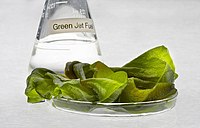
Photo from wikipedia
With realizing the potential of algal biomass as a good natural resource for the harnessing of valuable bioproducts, algal biomass production has gained a lot of interest in recent years.… Click to show full abstract
With realizing the potential of algal biomass as a good natural resource for the harnessing of valuable bioproducts, algal biomass production has gained a lot of interest in recent years. However, due to some limitations such as low harvesting efficiency, higher nutrient supply, and high water requirement, the production of algal biomass is uneconomical. Over the past several years, researchers are continuously working on growing algae as a biofilm for easy microalgae harvesting, concentration of algal biomass to a great extent, and requiring less quantity of water as compared to other microalgae cultivation methods. Most of the documented studies have been carried out on either use of algal biomass for tertiary treatment of wastewater or cultivation and harvesting of algal biomass for biofuel production. Limited research studies have documented other applications of the algal biofilm system. The present review paper summarizes the current knowledge on various factors affecting microalgae growth, development of algal biofilm, and operation of algal biofilm systems to help properly understand and optimize these factors for better economics, more positive environmental impacts, and successful potential applications of the attached growth systems. The important factors include the structure of algal biofilms, EPS matrix, supporting materials, nutrient availability, environmental conditions, and biofilm thickness and harvesting frequency. The potential applications such as wastewater treatment, CO2 sequestration, microalgae–microbial fuel cell, large-scale biomass production, and water quality improvement are also discussed.
Journal Title: Bioenergy Research
Year Published: 2020
Link to full text (if available)
Share on Social Media: Sign Up to like & get
recommendations!